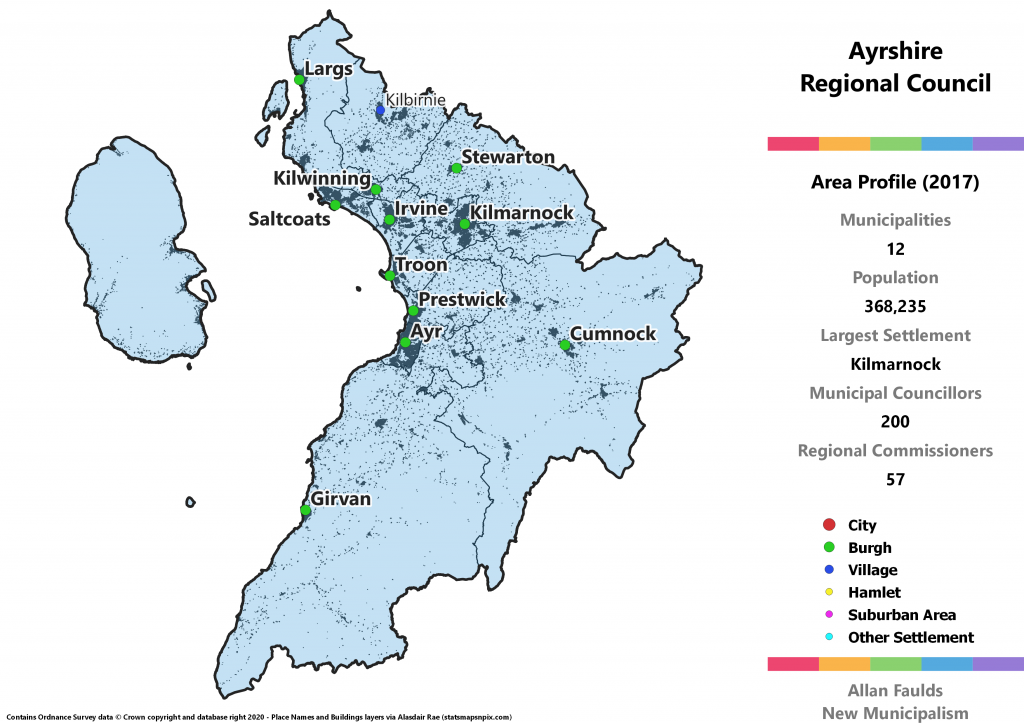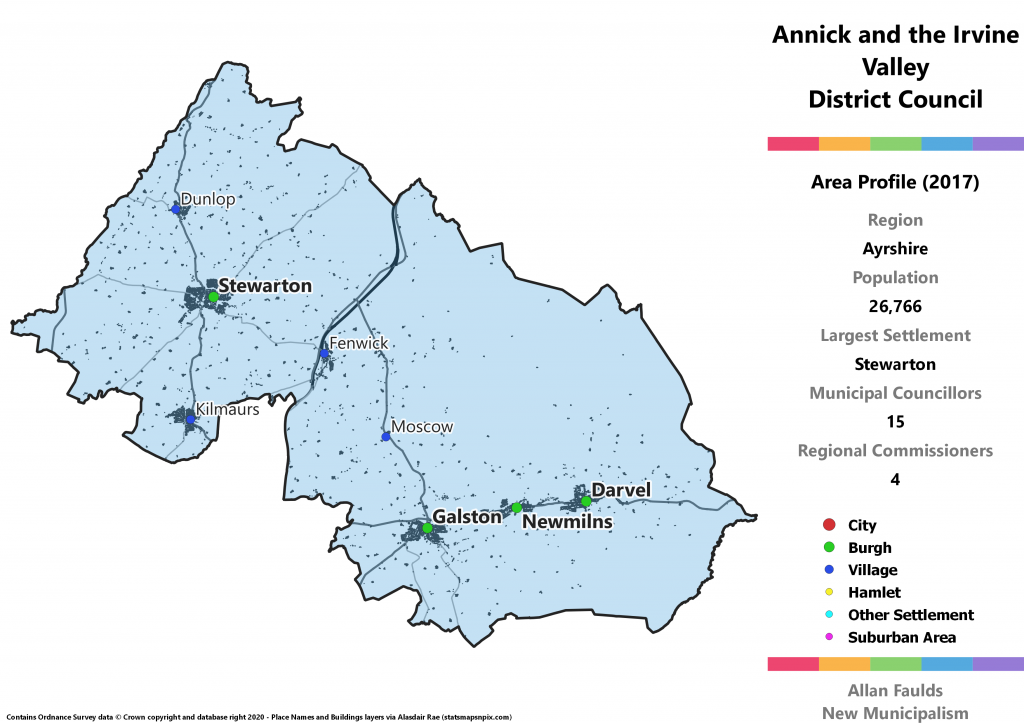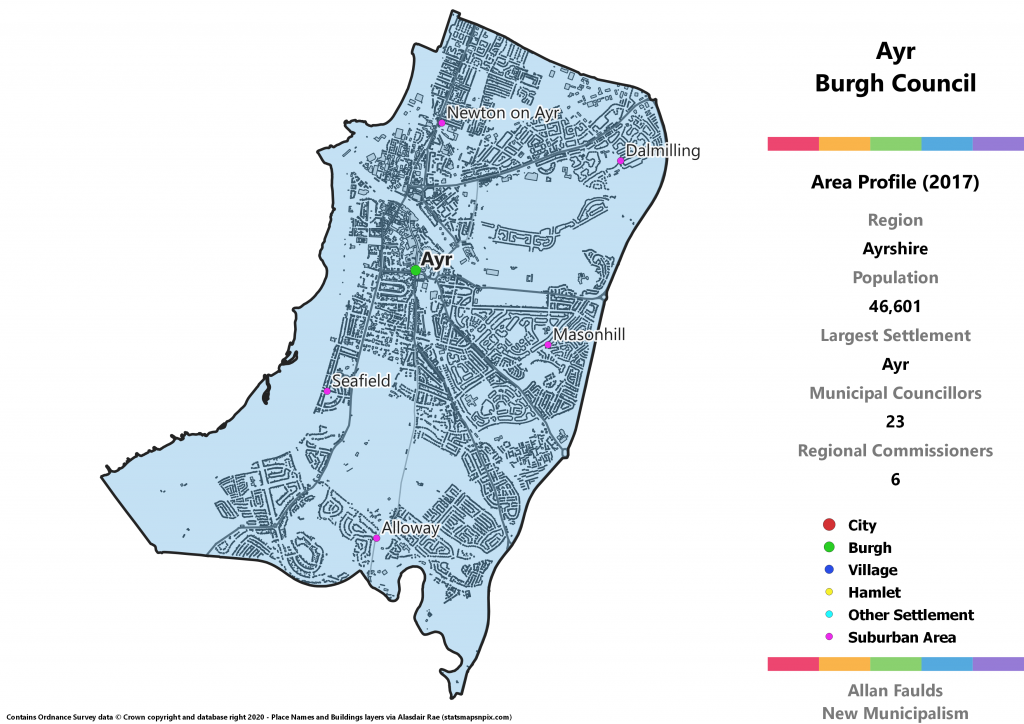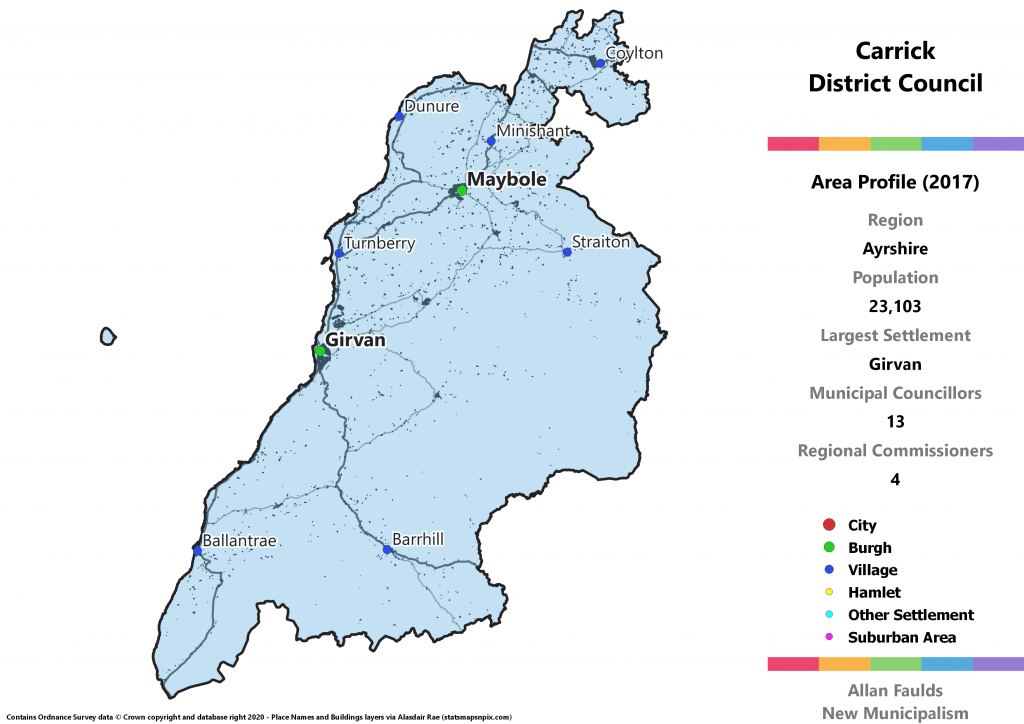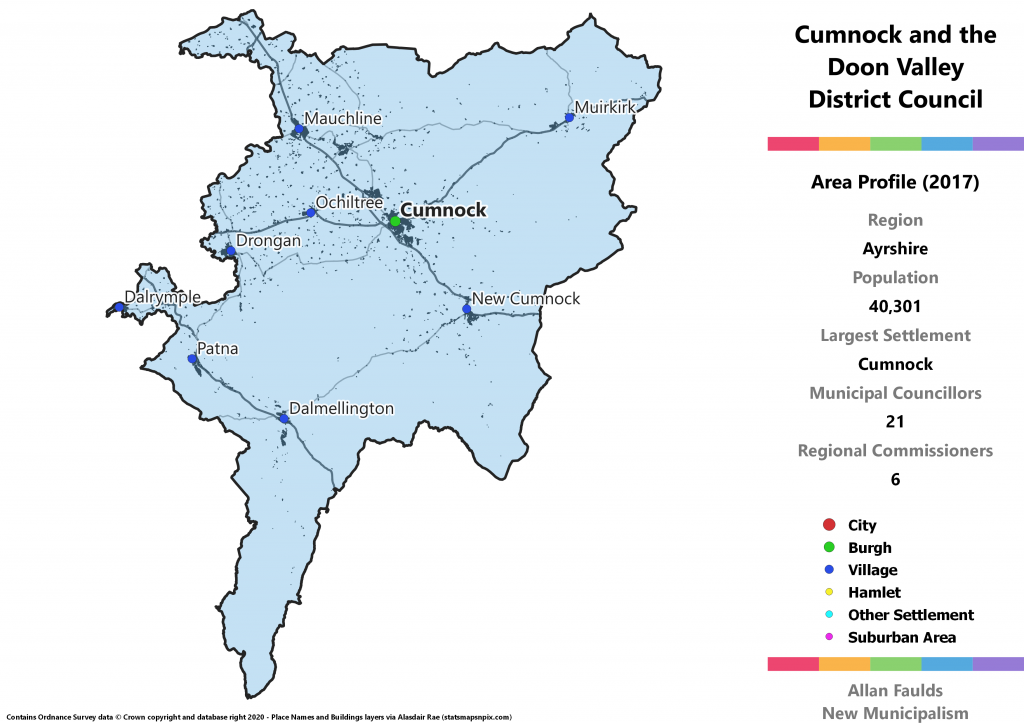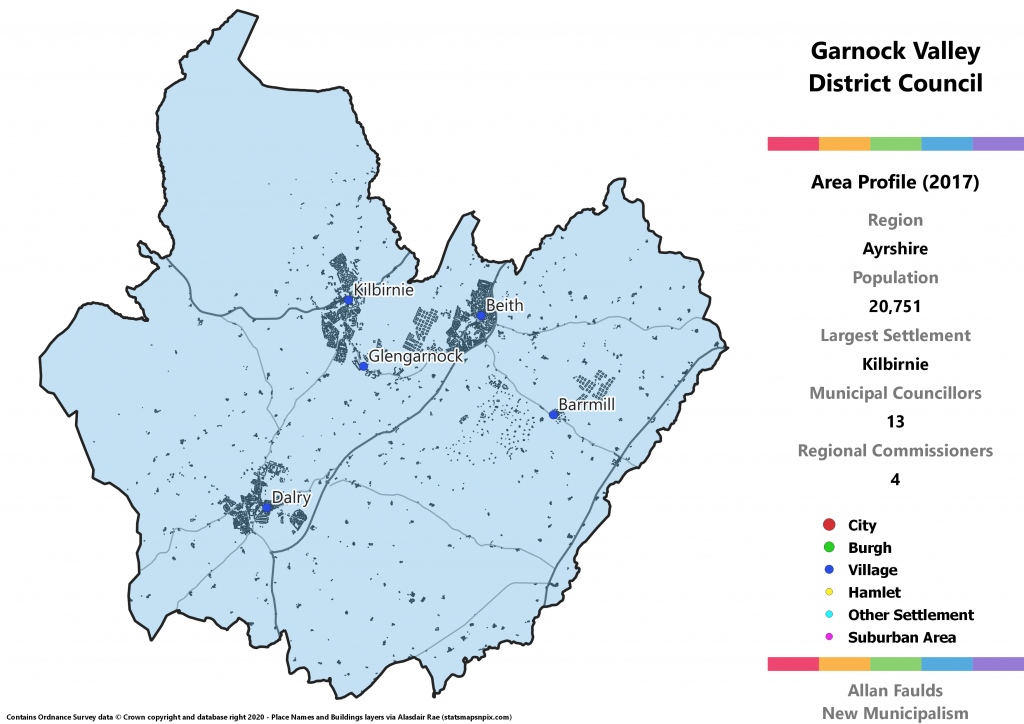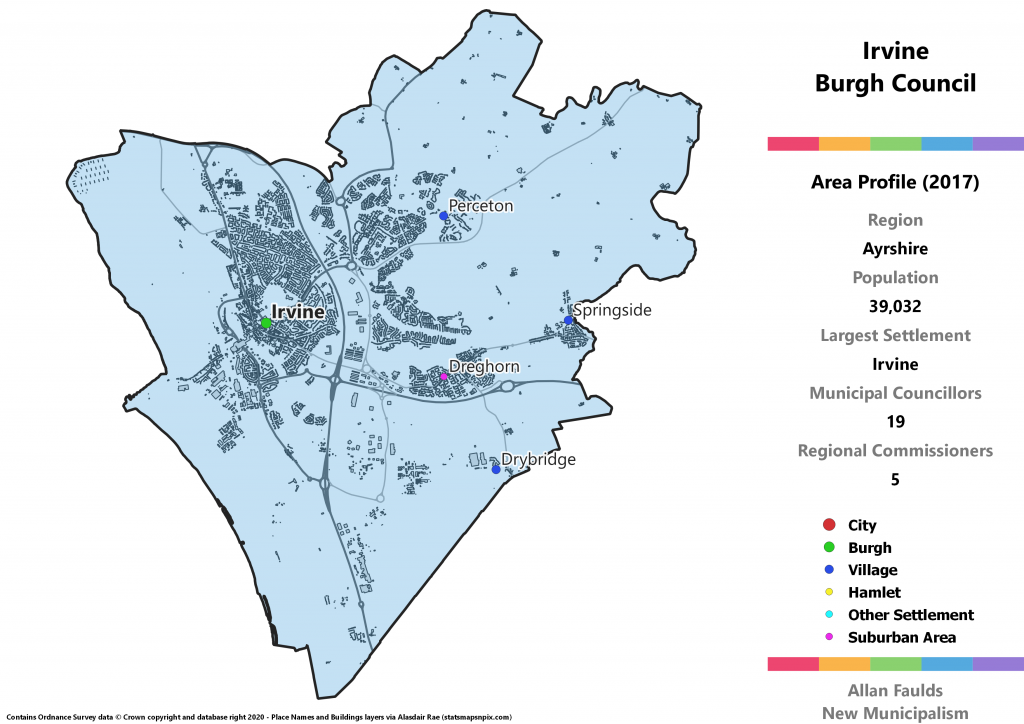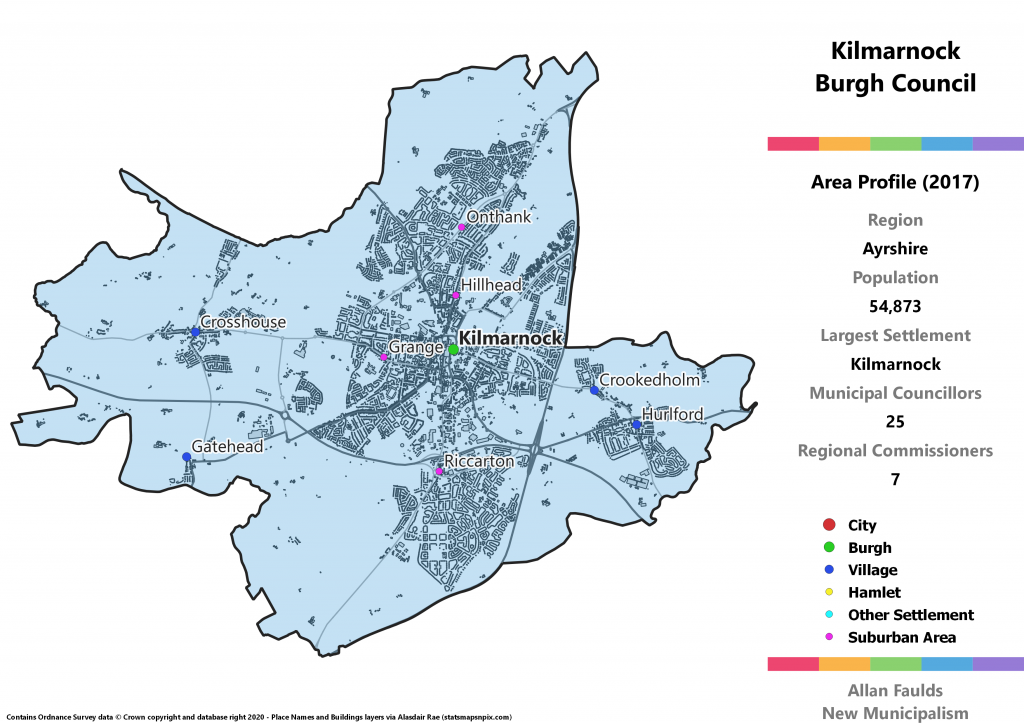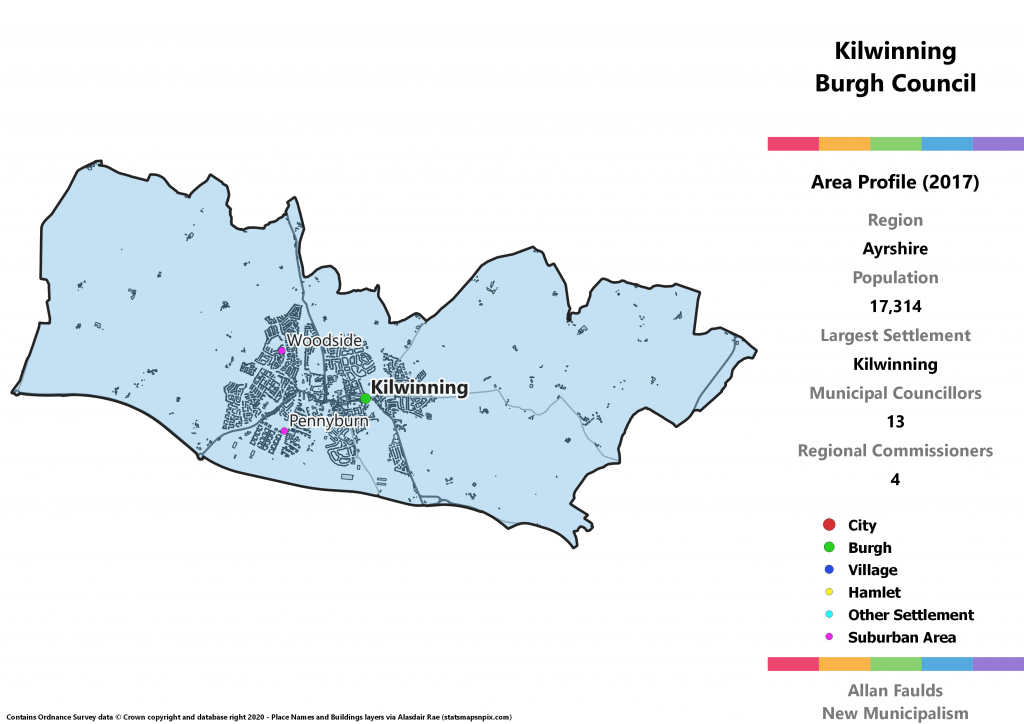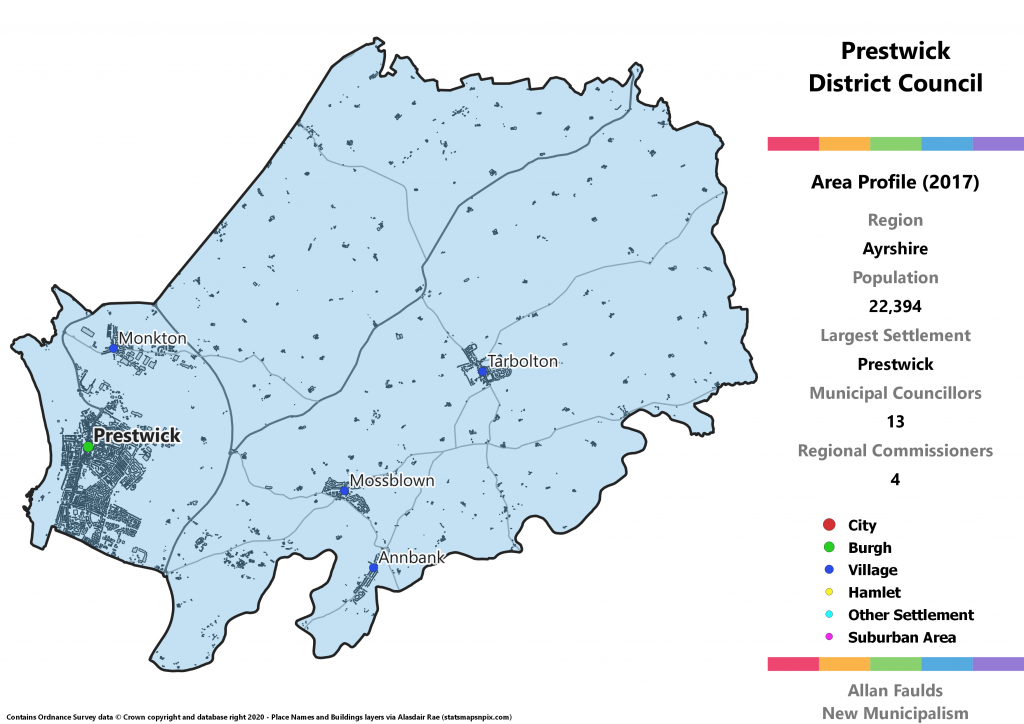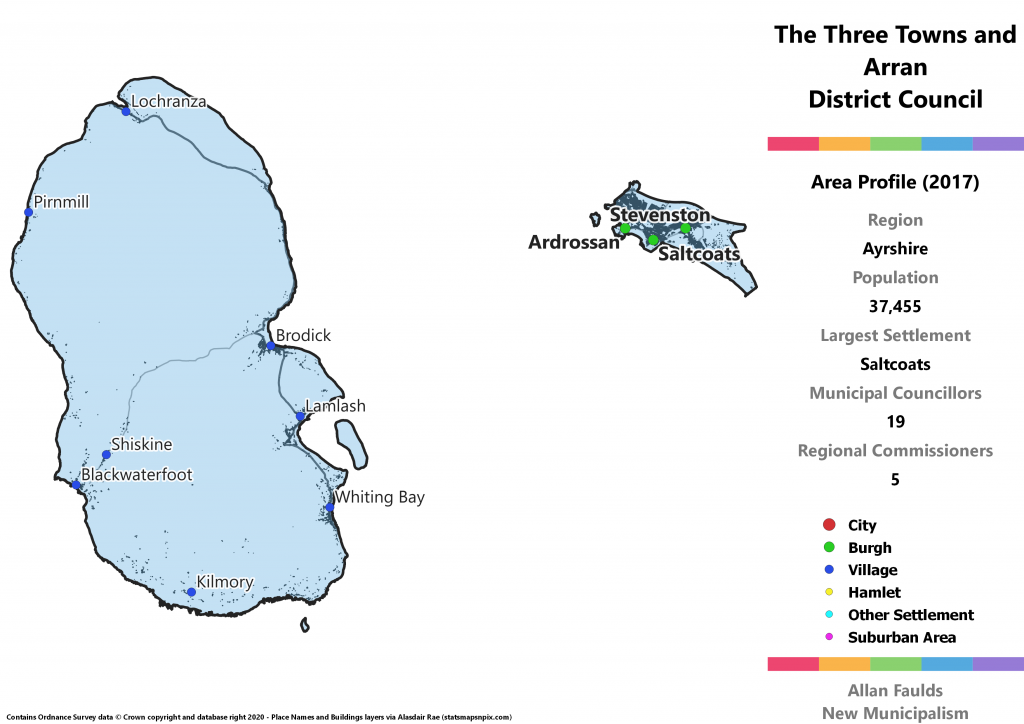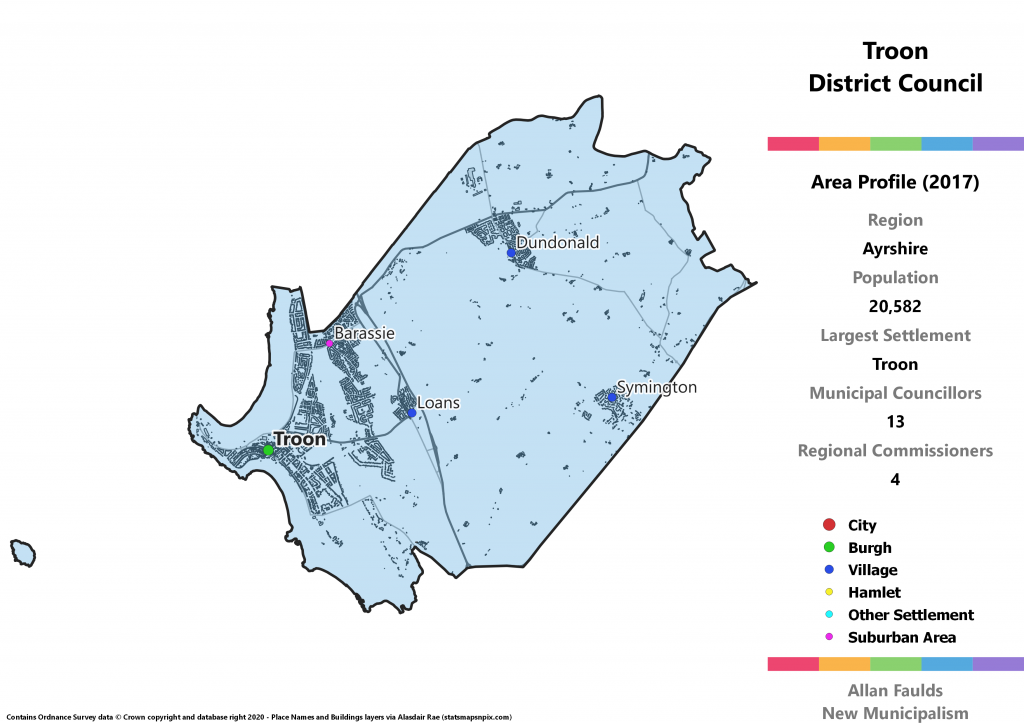Ayrshire Region Overview
Key Statistics
Municipalities: 12
Population: 368,235
Largest Settlement: Kilmarnock
Municipal Councillors: 200
Regional Commissioners: 57
Region Description
The Ayrshire region covers the historic county of the same name, except for the village of Skelmorlie which is ceded to Clyde. It also includes some islands in the Firth of Clyde, Arran and the Cumbraes, that were historically part of Buteshire but have been associated with North Ayrshire since the 1973 Act. Under that act, Ayrshire made up 4 districts within the absurdly over-sized Strathclyde region.
Although there were smaller counties like Banffshire and Selkirkshire that were quite sensibly rationalised in 1973, Ayrshire didn’t really justify that treatment. It’s true that the highly urbanised northern areas are part of an extended Glasgow commuter belt, but that alone isn’t good reason for a wider merger. It’s definitely big enough to justify its own region, and it has a very strong local identity to boot.
Ayrshire is notable for its notional lack of political diversity, having no Lib Dem or Green representatives either at Municipal or Regional level based on 2017 results. However, this is where my system of extrapolating from 2017 suffers most, as the Greens only stood in a handful of wards and the Lib Dems didn’t stand in any. More than any other region it’s therefore hard to have even a vague sense of the true level of support for those parties here, as you’d expect a wider rate of contest for them both with a stronger form of PR.
Amongst the three other parties, the SNP have become the strongest party in Ayrshire as a whole, with the Conservatives a reasonably close second. There are a couple of remaining pockets of Labour strength here as well.
Annick and the Irvine Valley District
Area Profile (2017)
Population: 26,766
Largest Settlement: Stewarton
Municipal Councillors: 15
Regional Commissioners: 4
Municipality Description
Annick and the Irvine Valley basically covers all the towns and villages surrounding Kilmarnock. The largest of these, Stewarton, lies to the north on the Annick Water that supplies part of the district name. Irvine Valley is the eastern portion, with the small historic burghs of Galston, Newmilns and Darvel. There isn’t necessarily brilliant integration between the two ends as it stands. Nonetheless, both would benefit from being a larger part of a smaller council.
A fun political quirk of this district would be the presence of the Rubbish Party on the council. That doesn’t even really need an extrapolation from 2017 to be sure of as said councillor, Sally Cogley, was elected as an Irvine Valley ward councillor. It was a point of some hilarity that, with a number of English local elections on the same day, the Rubbish Party won as many seats as UKIP did.
Ayr Burgh
Area Profile (2017)
Population: 46,601
Largest Settlement: Ayr
Municipal Councillors: 23
Regional Commissioners: 6
Municipality Description
Ayr has fared a little bit better than many old county towns. It’s been overtaken by Kilmarnock in population terms, but it’s still a very big town and one that rightly deserves to have the Burgh council it had before the 1973 Act restored. Although often perceived as a highly affluent town, there’s actually quite a divide between the north which features areas of substantial deprivation and the south with is indeed very comfortable.
Divided or not, Ayr is the largest town in Scotland that would have seen the Conservatives as the largest party on the council when extrapolating from real 2017 results.
Carrick District
Area Profile (2017)
Population: 23,103
Largest Settlement: Girvan
Municipal Councillors: 13
Regional Commissioners: 4
Municipality Description
You could describe this one more accurately as “Carrick and South Kyle”, as it takes in Coylton and a chunk of countryside to the east of Ayr. Carrick traditionally starts south of there, but seeing as it’s the bulk of the area and population of the district I just stuck with the simpler name. Although this contains the bulk of the rural area of the current South Ayrshire, it still centres on a reasonably large town in the form of Girvan. There isn’t much else that needs said for this one.
Cumnock and the Doon Valley District
Area Profile (2017)
Population: 40,301
Largest Settlement: Cumnock
Municipal Councillors: 21
Regional Commissioners: 6
Municipality Description
To all intents and purposes, Cumnock and the Doon Valley recreates the district of the same name from the 1973 Act. There’s a tiny bit of extra countryside in the north west that’s an artefact of me using current council wards as my main building block, but that doesn’t change much.
Most of the population here is found along the train line and road that passes through Machline, Cumnock and then New Cumnock. The Doon Valley portion accounts for that big southern spike which starts with Loch Doon then follows the river by or through Dalmellington, Patna and Dalrymple. As it covers most of the rural section of the current East Ayrshire, that makes it one of the two geographically extensive Ayrshire municipalities.
At a time when the Labour party haven’t been doing very well, Cumnock and the Doon Valley stands out as somewhere they hold onto some of their former strength. They’d have been the largest party on the council based on extrapolating 2017’s results.
Garnock Valley District
Area Profile (2017)
Population: 20,751
Largest Settlement: Kilbirnie
Municipal Councillors: 13
Regional Commissioners: 4
Municipality Description
Garnock Valley incorporates most of the inland portion of the current North Ayrshire. It’s a pretty unremarkable little district in the sense that it doesn’t need any extensive justification for existence, isn’t even partly recreating a past local government unit, and doesn’t have any political quirks.
Irvine Burgh
Area Profile (2017)
Population: 39,032
Largest Settlement: Irvine
Municipal Councillors: 19
Regional Commissioners: 5
Municipality Description
Irvine is the biggest town in the current North Ayrshire Council, and one of many major towns across Scotland that formerly had its own Burgh council and should do so again. The modern version would be substantially larger than the pre-1973 one, as the town seems to have expanded significantly since then, and it includes some surrounding villages and countryside as well.
This area is notable for having been where current First Minister of Scotland, Nicola Sturgeon grew up – specifically, she’s from Dreghorn. In spite of that connection, the SNP only narrowly came ahead of Labour here in 2017.
Kilmarnock Burgh
Area Profile (2017)
Population: 54,873
Largest Settlement: Kilmarnock
Municipal Councillors: 25
Regional Commissioners: 7
Municipality Description
Having overtaken Ayr, Kilmarnock is the largest town both in Ayrshire as a whole and in the current East Ayrshire Council area. Strictly speaking, Ayr was reckoned at the last count to have a whopping 10 more residents than Kilmarnock itself, but the proposed Burgh Council here benefits from having absorbed neighbouring villages to the west (Crosshouse) and east (Hurlford) that weren’t part of the pre-1973 Burgh. This is otherwise a pretty bog-standard, within the European norm municipality.
Kilwinning Burgh
Area Profile (2017)
Population: 17,314
Largest Settlement: Kilwinning
Municipal Councillors: 13
Regional Commissioners: 4
Municipality Description
Kilwinning stands out as an urban municipality which falls well short of the 20,000 mark I’m aiming for. I give a fair few rural municipalities a pass on the basis of geographic extent, so what happened here? Basically, an earlier version of this project had Kilwinning associated with the Garnock Valley district. A local connection of mine strenuously objected to this, indicating that Kilwinning had very little to do with that area, and much more to do with Irvine.
Since Irvine is already a big burgh by itself, I relented and gave Kilwinning its own council too. Although this project is “just for fun”, there’s a good reminder here that if and when Scotland does go through this much needed process of local government reorganisation, ordinary folk need to play a major role in the process of drawing up boundaries to ensure those have more legitimacy than either the 1973 or 1994 boundaries.
Like many such burghs, the town has expanded beyond the boundaries of the old pre-1973 burgh, and I’ve also included some of the surrounding rural area just as that has to go somewhere. Kilwinning is politically notable as one of those few places the Labour party are estimated to be the largest on the council.
Largs and the Cumbraes District
Area Profile (2017)
Population: 19,063
Largest Settlement: Largs
Municipal Councillors: 13
Regional Commissioners: 4
Municipality Description
This is where pinching Skelmorlie for the Clyde region comes back to haunt me slightly, as a Largs and the Cumbraes district created from the northern coastal portions of the current North Ayrshire then comes in below the 20,000 target without it. Since this includes islands, I feel it justifies what is normally my “rural waiver”.
Although there are two major islands here, Great and Lesser Cumbrae, only Great Cumbrae is actually inhabited these days. Almost entirely within the historic burgh of Millport, the island’s population would amount to about 7% of the whole district. That’d give residents there a much bigger voice on the council than they currently have in North Ayrshire, where they account for just 1% of the population.
The mainland towns and villages of Largs, Fairlie and West Kilbride are the most affluent parts of North Ayrshire – though not without their areas of deprivation. This is perhaps why it comes out as the only Ayrshire municipality outside of the current South Ayrshire Council to have a Conservative lead based on 2017 results.
Prestwick District
Area Profile (2017)
Population: 22,394
Largest Settlement: Prestwick
Municipal Councillors: 13
Regional Commissioners: 4
Municipality Description
As with the other districts carved out of the current North Ayrshire, Prestwick includes a chunk of the rural portion of Kyle and so could more accurately be named “Prestwick and Mid Kyle”. The town of Prestwick itself is effectively a northern suburb of Ayr these days, though it did have its own Burgh council pre-1973.
The villages of Mossblown and Tarbolton to the east are notably less affluent than Prestwick itself, which may help to explain how the Kyle ward was the only South Ayrshire ward outside of Ayr to have a combined SNP-Labour vote higher than the Conservatives. Nonethless, this district follows the South Ayrshire trend of a Conservative lead after extrapolating 2017 results.
The Three Towns and Arran District
Area Profile (2017)
Population: 37,455
Largest Settlement: Saltcoats
Municipal Councillors: 19
Regional Commissioners: 5
Municipality Description
For folk who may be unfamiliar with the area, “The Three Towns and Arran” isn’t unimaginative and lazy naming on my part. Ardrossan, Saltcoats and Stevenston are genuinely known by that name when referring to them collectively, having all grown into one another by this point. Historically all three had their own burgh councils, but even if any one of them had a large enough population to meet this project’s target, there wouldn’t be much point to separating them.
Including the isle of Arran in this district may feel like a bit of an odd fit, but it’s the only sensible place. The main ferry connection between Arran and the mainland is at Ardrossan, so there’s some transport rationale. And with a population a bit under 5,000, it just felt far too small to waive the 20,000 target to give the island a standalone council.
All that said, Arran would make up just over 12% of the district’s overall population, versus the 3% of North Ayrshire’s. Although this project doesn’t give smaller islands their own councils, it would massively strengthen their voice versus the status quo.
Troon District
Area Profile (2017)
Population: 20,582
Largest Settlement: Troon
Municipal Councillors: 13
Regional Commissioners: 4
Municipality Description
Coverning the northernmost portion of the current South Ayrshire Council, you could append “and North Kyle” to the end of Troon if you felt the need for a clearer geographic description. Troon is another of those historic Burghs, which included Barassie even back in the old days. It’s the more rural portion to the east that’s effectively new here, incorporating the villages of Loans, Symington and Dundonald.
Troon is a bit similar to Ayr in that it has a reputation for affluence, but actually has some areas of substantial deprivation per SIMD 2016. Regardless, in a part of the country known for its Conservative leanings, Troon would have seen the party’s best result based on 2017 results, delivering a rare single party majority.
